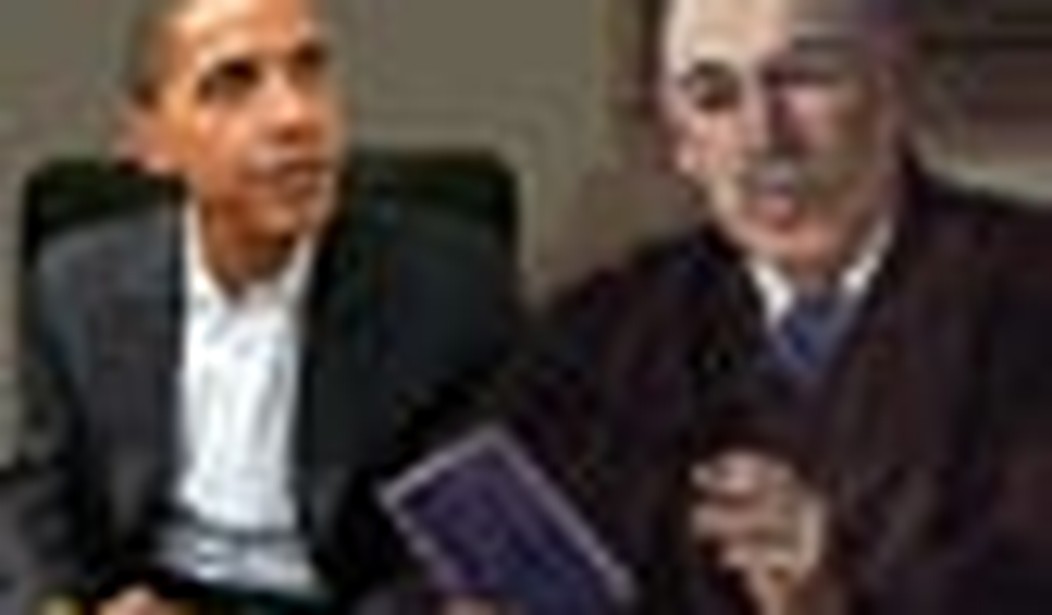A New York Times item earlier this month about steps President Barack Obama might be considering to turn around America’s moribund economy caught my attention more for what it didn’t say than what it did, specifically in the following sentence:
A wide range of economists say the administration should call for a new round of stimulus spending, as prescribed by mainstream economic theory, to create jobs and promote growth. It is clear that the House would never pass such a plan.
Times reporters Binyamin Appelbaum and Helene Cooper oddly never revealed that this “mainstream economic theory” subscribed to by “a wide range of economists” goes by a specific name: Keynesianism.
What a remarkable change from just a couple of years ago, when the Times routinely invoked the late English economist and his principles. A ridiculously biased and badly-in-need-of-updating Wikipedia entry on Keynes describes 2008-2009 as the “Keynesian resurgence.” Serendipitously, on the last day of that two-year period, I was asking, “Economic Rebound? What Economic Rebound?” I’m still asking.
Far less than two years after the “resurgence,” odious Times columnist Paul Krugman demonstrated the utter bankruptcy of current Keynesian thought. In a televised CNN discussion on August 12, he suggested an out-of-this-world idea:
If we discovered that space aliens were planning to attack and we needed a massive buildup to counter the space alien threat and really inflation and budget deficits took secondary place to that, this slump would be over in 18 months.
This really should not have been surprising. Days after the September 11, 2001, terrorist attacks, Krugman wrote:
Ghastly as it may seem to say this, the terror attack — like the original day of infamy, which brought an end to the Great Depression — could even do some economic good.
You read that right. Keynes’s leading U.S. apologist admitted that nearly a decade of Keynesianism applied to the U.S. economy failed to end the Great Depression. In fact, unemployment during the 1930s until the onset of World War II was never less than 12%. In Krugman’s warped view, Keynesianism has never really been tried, because no one has ever spent enough to give the theory a fair test.
But surely there is a basis for believing that Keynesian approaches should and sometimes actually do work, right? After all, it was “the dominant view in the economics profession for at least the next forty years” after the Depression.
The fundamental problem with Keynesianism is, with rare exceptions, essentially the same as as the one with most generals’ battle plans, as expressed by Colin Powell: “No battle plan survives contact with the enemy.” Similarly, with perhaps the rarest of exceptions long, long ago, no Keynesian economic plan has ever survived contact with the government attempting to execute it. Governments have seriously abused Keynes’s original assertions, and have become so big and corrupt themselves that they are functionally incapable of successfully carrying out any attempted “Keynesian” stimulus which might theoretically work.
To fully vet my contention, let’s look at Keynes’s fundamental tenets as stated in a succinct adaptation from Commanding Heights, a highly complimentary 1998 book by Daniel A. Yergin and Joseph Stanislaw (bolds and numbered tags are mine):
… (Keynes) concluded that classical economics rested on a fundamental error. It assumed, mistakenly, that the balance between supply and demand would ensure full employment. On the contrary, in Keynes’s view, the economy was chronically unstable and subject to fluctuations, and supply and demand could well balance out at an equilibrium that did not deliver full employment. [1] The reasons were inadequate investment and over-saving, both rooted in the psychology of uncertainty.
… The solution to this conundrum was seemingly simple: Replace the missing private investment with public investment, financed by deliberate deficits. The government would borrow money to spend on such things as public works; and that deficit spending, in turn, would create jobs and increase purchasing power. [2] Striving to balance the government’s budget during a slump would make things worse, not better. … As a corollary, the government would cut back its spending during times of recovery and expansion. [3]
… Keynes intended government to play a much larger role in the economy. His vision was one of reformed capitalism, managed capitalism—capitalism saved both from socialism and from itself. He talked about a “somewhat comprehensive socialization of investment” and the state’s taking “an ever greater responsibility for directly organizing investment.” Fiscal policy would enable wise managers to stabilize the economy without resorting to actual controls. The bulk of decision making would remain with the decentralized market rather than with the central planner. [4]
… Keynes provided both a specific rationale for government’s taking a bigger role in the economy and a more general confidence in the ability of government to intervene and manage effectively. Despite Keynes’s fascination with uncertainty and his speculative talents in the marketplace, Keynesians deemed “government knowledge” to be superior to that of the marketplace. [5]
… How far reaching its impact, or at least the perception of its impact, was demonstrated by a history of economic thought published in the mid-1960s: “In most Western economies Keynesian theory has laid the intellectual foundations for a managed and welfare-oriented form of capitalism. Indeed, the widespread absorption of the Keynesian message has in large measure been responsible for the generally high levels of employment achieved by most Western industrial countries since the second world war and for a significant reorientation in attitudes toward the role of the state in economic life.” [6]
… It was not until the 1970s [7] that evidence began to accumulate in many countries that Keynes’s theories, at least as implemented by Keynes’s advocates after his death, might not perpetually yield the favorable outcomes Keynes himself had predicted.
Notes:
- [1] — One wonders how humanity ever progressed to the point it did by the 1930s if Keynes was really right. Logically, throughout the course of history we should have seen market-oriented cultures around the world chronically underutilizing their resources and capabilities for extended periods of time, incapable of turning things around on their own. We didn’t. In fact, only a decade earlier, the U.S. recovered remarkably well from the very serious depression of 1920-21 despite the fact that the government of President Warren Harding did very little to intervene. The economy corrected itself, and fairly quickly, leading to the Roaring ’20s.
- [2] — There are two problems here. First, as President Obama himself admitted to the New York Times in 2010, “there’s no such thing as shovel-ready projects.” Although that was perhaps less true in the 1930s — ironically, because of today’s environmental red tape — it remains a fact that the government could not then as it cannot now hit the ground running with infrastructure spending. This leads to the second problem, which is that impatient, desperate politicians who want to pump money into the economy right now falsely invoke Keynes to justify throwing money at entitlement and other spending programs, demanding nothing of value in return. In the 1960s and 1970s, this outlook was expressed thusly: “It doesn’t matter what you spend it on, just spend it!” More recently, it has led to outrageous assertions by out-of-ideas politicians like former House Speaker Nancy Pelosi and Ohio Senator Sherrod Brown that money spent on unemployment benefits is one of the best forms of stimulus available.
- [3] — Perhaps the biggest weakness of Keynesian thought is the naive belief that any government which gets used to spending more money will voluntarily acquiesce to spending less. It doesn’t happen, not even, as seen in recent years, when economic calamity clearly looms.
- [4] — During the 1930s, which many history textbooks still regard as when “FDR saved us from the depression,” President Franklin Roosevelt “somehow” forgot about Keynes’s admonishment to avoid controls. In perhaps the most comprehensive program of status quo-protecting crony capitalism in history, FDR’s National Recovery Act required every major industry “to draw up a code setting production quotas, limiting hours of operation, or restricting construction of new factories.” In general, governments find it almost impossible to avoid exerting undue and almost invariably harmful influence over an economy as they abscond with an ever larger percentage of its fruits. Recent examples include actions too numerous to mention taken by the Obama administration’s ever-encroaching regulatory apparatus.
- [5] — This is yet another fatal Keynesian conceit. As many non-Keynesian economists and commentators have stated over the years, the idea that central planners can do a better job of managing an economy’s trillions of individual transactions and interactions better than the market’s everyday participants reflects the unbounded hubris of those who adhere to it, and has no support in the actual results of human history.
- [6] — This is an especially odd belief in light of what really happened after World War II. For some reason, the 1950s is still idealized as a period of exceptional countrywide Keynesian prosperity. In reality, average annual real GDP growth from 1951-1960, an era also characterized by Big Labor and Big Business dominance of the private sector and extraordinarily high marginal income tax rates, was just above 3.5%. Given that America was still the only major power left standing, it should have greatly exceeded that. But during the five years following the John F. Kennedy-inspired income tax cuts of 1964 — a decidedly non-Keynesian action — the economy grew by an annual average of over 5%. The decade of the 1970s and its reversion to Keynesianism, during which Richard Nixon actually said, “I am now a Keynesian in economics,” was extraordinarily unimpressive, and marked in its later years by ruinous double-digit inflation and interest rates. In the 1980s, Ronald Reagan’s anti-Keynesian tax cuts, driven by a classical economist’s faith in the people, gave us The Seven Fat Years. More recently, capital gains tax cuts in 1997 led to that decade’s final-years boom, and George W. Bush’s relatively modest but supply side-oriented cuts in 2003 led to 34 consecutive months where the seasonally adjusted unemployment rate was 5% or lower (July 2005 through April 2008).
- [7] — The evidence of suboptimal results was really there in the 1930s, but the elites who controlled the political establishment and had a virtual stranglehold on the media consciously chose to ignore it.
Though it may not be fair to assign all of its results to Keynes and his theories, the ascension of Keynesianism as applied in the real world, its brief 2008-2009 return, and its still-present dominance of hidebound thought in academia and government were and still are products of an elitist class which feels that it alone possesses the intelligence and ideas which will make the world genuinely better. It has always been accompanied by a profound disregard for the wishes, dreams, and plans of others who will not conform to their supposedly enlightened vision. In the past three years, its application and misapplication have led the greatest economy ever seen on earth swiftly and dangerously down the path towards bankruptcy.









Join the conversation as a VIP Member